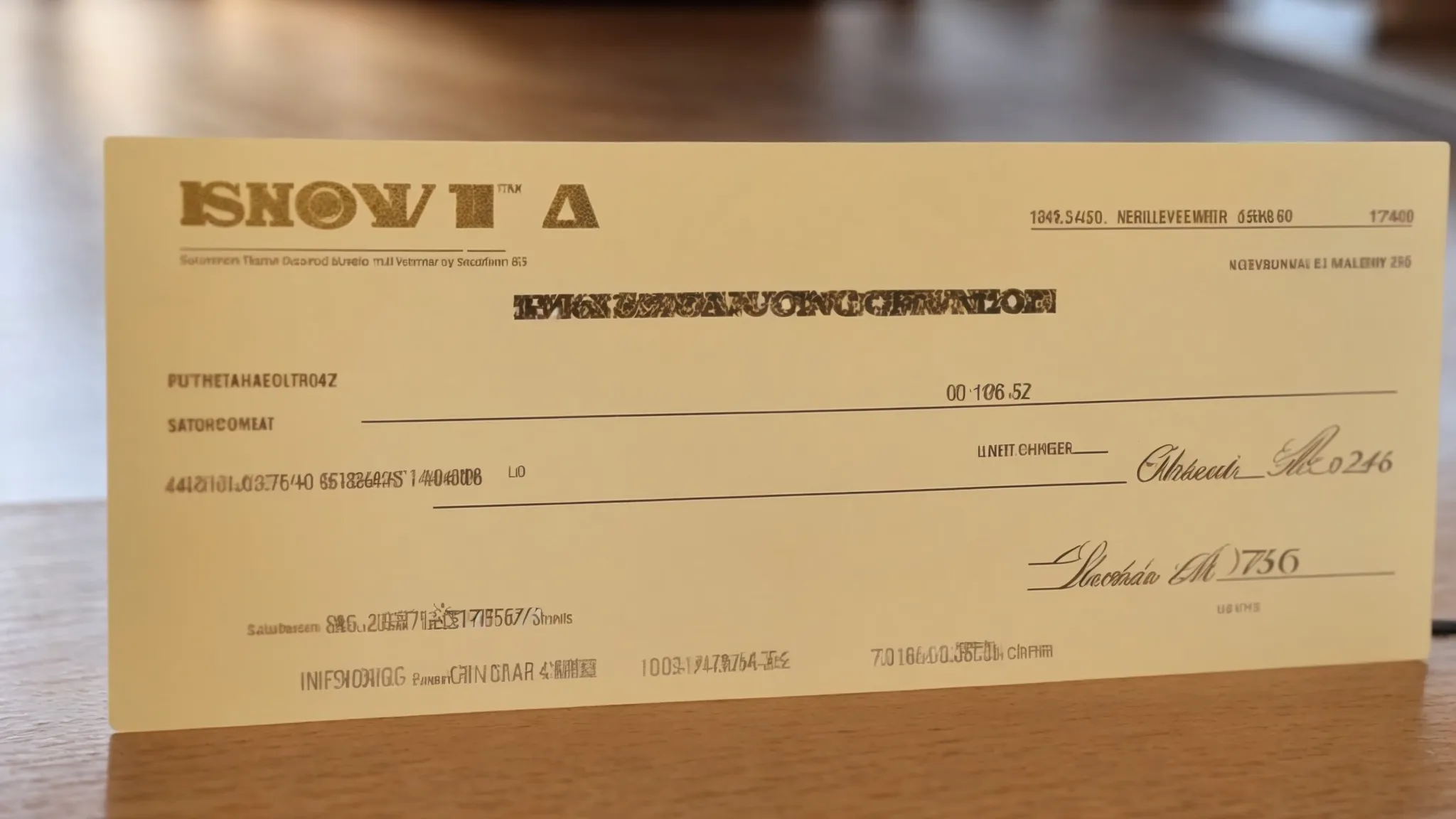Fraudulent cheque detection is crucial for any business, yet many owners underestimate its importance. Did you know that check fraud costs businesses millions every year? In this blog post, readers will learn about the common signs of check fraud, practical strategies to prevent it, and steps to take if they encounter a counterfeit check. By understanding these key aspects of risk management and authentication, business owners can better protect themselves and ensure their operations run smoothly. This knowledge will help alleviate concerns about cheque scams and enhance overall security in financial transactions.
What Does Check Fraud Look Like?

Check fraud manifests in several forms, each posing significant risks to businesses and individuals. Altered checks involve modifications made to change the amount or payee, while forged checks feature unauthorized signatures. Counterfeit checks are entirely fake documents designed to mimic legitimate ones. Understanding these types of check fraud can aid accountants, financial officers, and business owners in implementing effective check fraud detection measures, ensuring security for their line of credit and direct deposit transactions.
Altered Checks
Altered checks are a common type of check fraud that can cause significant losses to businesses and individuals. They typically involve changes made to the original document, such as modifying the payee name or altering the payment amount. Financial institutions often recommend using advanced security measures, such as biometrics, to help verify the authenticity of a check. By maintaining vigilance and understanding these alterations, organizations can better protect their revenue and minimize the risk of losses associated with counterfeit checks.
Recognizing signs of altered checks is essential for mitigating fraud risks. For instance, if a company experiences check kiting, where funds are withdrawn from one account to cover another, it can signal alterations or date changes on the check. This type of manipulation not only undermines the integrity of a financial transaction but also challenges the stability of a business’s cash flow. By employing thorough review processes and utilizing technology for check validation, businesses can safeguard against the impacts of altered checks and enhance their overall financial security.
Forged Checks
Forged checks present a serious risk to businesses, often designed to look like legitimate instruments while containing unauthorized signatures. Financial professionals must remain adept at identifying signs of check fraud, particularly as cybercriminals increasingly employ malware to create convincing counterfeit documents. Staying informed about these tactics and employing stringent verification processes can help organizations avoid costly losses.
In practical terms, businesses can implement measures such as dual verification for large transactions, particularly those involving wire transfers. An effective approach can include contacting the payee directly to confirm the legitimacy of the transaction before processing it. By taking these proactive steps, companies can significantly reduce their exposure to check fraud and protect their financial integrity.
Counterfeit Checks
Counterfeit checks pose a significant threat to businesses and individuals, often resulting in financial losses and identity theft. Criminals design these fake checks to replicate legitimate ones closely, tricking employees who may not be aware of the signs of fraud. Companies need to focus on implementing effective wealth management strategies that include regular training for staff, ensuring they can identify counterfeit checks and protecting working capital from fraudulent activities.
To combat the issue of counterfeit checks, organizations can leverage technology, such as check verification systems, which can quickly detect inconsistencies in check details. These systems play a crucial role in safeguarding cash transfers and preventing unauthorized transactions. By fostering a culture of vigilance and awareness among employees, businesses can significantly reduce their exposure to counterfeit check fraud and maintain the integrity of their financial transactions.
Understanding what check fraud looks like can save your business heartache and money. Now, let’s explore how you can keep your hard-earned cash secure from such threats.
How to Prevent Check Fraud

To safeguard against check fraud, small businesses must adopt several strategies that enhance security and protect their bank accounts. Key preventive measures include utilizing online payment methods, implementing money transfer applications, and opting for wire transfers for transactions. Further, requesting bank-sent checks, exercising caution when writing checks, and employing positive pay services contribute significantly to protecting one’s wealth against scams. Additional options like high-security check designs and chemically reactive check paper enhance overall security, making fraudulent attempts more difficult.
Use Online Payment Methods
Utilizing online payment methods such as ACH transfers and mobile banking can significantly reduce the risk of check fraud for both businesses and customers. By relying on these secured digital alternatives, organizations minimize the chances of falling victim to cybercrime that often targets traditional cheque transactions. These methods enable faster transactions and provide users with real-time monitoring capabilities, enhancing overall financial behavior and control.
Moreover, businesses can educate their customers about the benefits of online payments, emphasizing their security features compared to physical checks. Encouraging clients to opt for ACH transfers or mobile banking can lead to a more streamlined payment process while protecting sensitive financial information. This proactive approach not only helps to safeguard against fraudulent activities but also builds trust within customer relationships, addressing their concerns about security and reliability.
Implement Money Transfer Applications
Implementing money transfer applications is a proactive measure businesses can take to mitigate the risks associated with check fraud. These digital platforms offer a secure alternative to traditional cheques, minimizing the likelihood of criminal activities targeting physical transactions. By utilizing online banking services and mobile payment solutions, organizations can streamline their payment processes while enhancing security against potential fraud.
Financial institutions increasingly endorse the adoption of money transfer applications as a safeguard against check-related crime. Such solutions not only facilitate quicker transactions but also provide robust tracking and monitoring features, allowing businesses to maintain control over their finances. As companies navigate challenges such as mergers and acquisitions, integrating these modern payment methods can help protect valuable assets from fraudulent activity, ensuring that funds are secure and efficiently managed.
Use Wire Transfers for Transactions
Utilizing wire transfers for transactions can significantly enhance security against cheque fraud, particularly given the growing threats posed by email spoofing and other cybercriminal tactics. With wire transfers, funds are transferred electronically between banks, providing a more secure method compared to traditional cheques that can be easily altered or forged. Organizations that implement treasury management practices understand that this approach minimizes risk and protects their assets from potential fraud.
In addition to the reduction of cheque fraud exposure, wire transfers ensure that transactions are confirmed through secure channels, thereby decreasing the chances of unauthorized access. Unlike physical cheques that rely on magnetic ink character recognition, which can be manipulated, wire transfers create a direct and traceable connection between sender and receiver. By adopting this modern payment method, businesses can move towards increased safety in their financial operations, safeguarding their bottom line against fraud-related losses.
Request Bank-Sent Checks
Requesting bank-sent checks is a valuable strategy in the fight against fraud, particularly in a landscape where social engineering and theft tactics have become increasingly sophisticated. By opting for checks that originate directly from financial institutions, businesses minimize the risk of alterations and forgeries, ensuring greater integrity in their transactions. This innovative approach not only safeguards against potential fraud but also enhances peace of mind for both the issuer and the recipient.
Incorporating analytics into the process of requesting bank-sent checks further strengthens security measures. By monitoring patterns and identifying anomalies in transactions, organizations can quickly detect potential fraud attempts. This proactive use of data enables businesses to respond effectively to threats and reinforce their defenses against fraudulent activities, ultimately fostering more secure financial practices.
Exercise Caution When Writing Checks
Exercising caution when writing cheques is vital for businesses seeking to protect their financial interests. By using clear and legible handwriting, owners can reduce the risk of alterations that may lead to fraudulent activities. Additionally, being vigilant about who the cheque is issued to, including confirming details related to credit and transactions, serves as a fundamental practice in maintaining integrity within the supply chain.
Furthermore, implementing a consistent process for cheque issuance can significantly bolster security measures. For instance, ensuring that each cheque is tracked and recorded helps businesses manage their funds effectively and aids in investment management. This approach not only strengthens financial oversight but also fortifies defenses against potential fraud, making it essential for any organization committed to safeguarding their assets.
Utilize Positive Pay Services
Utilizing positive pay services is a proactive measure that can significantly strengthen defenses against check fraud. This service enables businesses to provide their bank with a list of checks they have issued, along with details such as amounts and payee names. By doing so, banks can verify each presented check against the provided list, ensuring that only authorized transactions are processed, thus helping organizations prevent fraud.
In the face of increasing phishing attacks and fraudulent schemes targeting businesses, positive pay services reinforce data integrity in financial transactions. This approach minimizes the risk of unauthorized checks being cashed and provides an additional layer of security against potential fraud attempts. Engaging with this service creates a systematic way to manage check issuance, ensuring that businesses can maintain control and stability over their finances.
Opt for High-Security Check Designs
Opting for high-security check designs is a critical step in fraud prevention for businesses handling payroll and invoice transactions. These checks often incorporate advanced features such as watermarks, color-shifting ink, and invisible fibers that make reproduction nearly impossible. By utilizing checks with these security enhancements, organizations can significantly reduce the risk of unauthorized alterations and counterfeiting.
Furthermore, integrating machine learning technology into the payment process can enhance the detection of any fraudulent activities associated with these high-security checks. By monitoring transaction patterns and flagging anomalies, businesses can take swift action against potential threats. This proactive approach not only helps protect a company’s financial integrity but also builds trust with employees and clients who rely on the security of their payroll and invoicing processes.
Choose Chemically Reactive Check Paper
Choosing chemically reactive check paper is a crucial step in preventing check fraud. This paper reacts to attempts of chemical alteration, rendering fraudulent modifications visible to the naked eye. By using this type of paper, businesses can significantly reduce the chances of unauthorized alterations and enhance the security of their financial transactions.
Incorporating chemically reactive check paper into accounting practices not only protects against fraud but also demonstrates a commitment to ensuring financial integrity. Organizations that adopt this security measure exhibit diligence in safeguarding their assets against fraudulent activities, which ultimately fosters trust among clients and stakeholders. By prioritizing security features like chemically reactive check paper, businesses can confidently manage their financial operations while mitigating potential risks associated with check fraud.
Even with the best defenses, counterfeit checks can still slip through the cracks. When that moment arrives, knowing how to respond becomes essential to protecting your business and finances.
What Happens if You Encounter a Counterfeit Check?

When a counterfeit check is discovered, it is imperative to act swiftly. The organization must immediately cease any transactions connected to the fraudulent instrument to limit potential losses. Prompt reporting to the bank helps initiate an investigation into the matter.
Next, businesses should document all relevant details regarding the counterfeit check, including the check number, amount, and any associated names or accounts. This information will assist law enforcement and banking authorities in their investigation of the fraud. Keeping accurate records ensures a clearer understanding of the incident.
It is also advisable for organizations to notify customers who may have received or dealt with the counterfeit check. By spreading awareness, businesses can help prevent others from falling victim to the same fraudulent scheme. Such proactive communication reinforces trust and transparency with stakeholders.
Lastly, reviewing internal processes can identify vulnerabilities and reinforce security measures against future incidents. Implementing strict check verification procedures, alongside staff training on detecting counterfeit checks, can enhance overall fraud prevention efforts. This comprehensive approach fosters a safer financial environment for the organization.
Counterfeit checks can ruin lives and drain resources. If you find yourself trapped in this situation, knowing the right steps to take is crucial.
Actions to Take if You Fall Victim to Check Fraud

Upon discovering that a business has fallen victim to cheque fraud, it is essential to take immediate action. The first step involves halting any related transactions to prevent further loss and protect financial assets.
Next, reporting the incident to the bank should occur without delay. This action is critical as it helps trigger an investigation into the fraudulent cheque and assists in tracing any unauthorized activity.
Businesses must document all pertinent details regarding the fraudulent cheque, such as the cheque number, amount, and any names or accounts involved. Accurate records support law enforcement and banking authorities in understanding the situation and pursuing necessary actions.
Finally, notifying affected customers creates awareness about the cheque fraud incident. This step not only informs clients but also fosters trust by demonstrating transparency and commitment to their security during this challenging time.
Check fraud can leave lasting scars, but knowledge is a powerful remedy. Discovering more about check fraud detection will equip you to protect your business and your peace of mind.
Resources for Further Learning on Check Fraud Detection

To enhance understanding of fraudulent cheque detection, several resources are available. Helpful websites provide practical tips and tools for identifying check fraud. Industry reports offer insights into current trends and statistics surrounding cheque fraud. Additionally, recommended books and guides present in-depth knowledge and strategies to combat these issues. Leveraging these resources equips businesses with essential skills to detect and prevent fraudulent cheques.
Helpful Websites
Many helpful websites are dedicated to providing comprehensive resources for check fraud detection. For instance, the Association for Financial Professionals offers valuable guidelines on recognizing and preventing fraudulent cheques. Their insights can help businesses stay informed about the latest tactics used by criminals, enabling them to adopt effective prevention strategies and safeguard their financial assets.
Another useful resource is the Federal Trade Commission’s website, which presents a wealth of information on various types of fraud, including check fraud. By exploring their publications, business owners can gain practical tools and tips to enhance their fraud detection efforts. Engaging with these resources empowers organizations to create a proactive approach to financial security and reduce the risks associated with fraudulent cheque activities.
Industry Reports
Industry reports play a vital role in enhancing knowledge about cheque fraud detection. These reports provide insights into emerging trends, threats, and statistics related to fraudulent cheque activities. By analyzing findings from credible sources, businesses can identify common vulnerabilities and adjust their security measures accordingly, ultimately protecting their financial health.
Recommended Books and Guides
Books such as “Fraud Prevention: A Guide to Detecting and Preventing Financial Crime” provide valuable insights into the nuances of cheque fraud detection. They offer practical advice on identifying signs of fraud, making them essential resources for financial professionals and business owners. Each chapter outlines real-life scenarios and techniques that can empower readers to enhance their preventive measures against fraudulent cheques.
Guides like “Understanding Check Fraud and How to Combat It” delve into various tactics criminals use, offering strategies for organizations to strengthen their defenses. These resources emphasize the importance of vigilance and ongoing education, equipping readers with actionable steps to safeguard their financial transactions. By engaging with these materials, businesses can build a comprehensive understanding of cheque fraud risks and effective detection practices.

